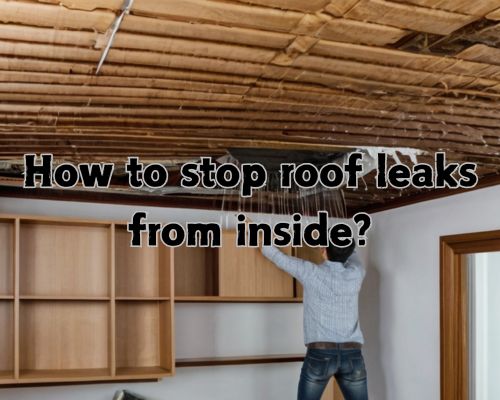How to Stop Roof Leaks from Inside: Effective Solutions and Tips

How to Stop Roof Leaks from Inside: Effective Solutions and Tips
Dealing with a leaky roof can be daunting, especially when the rain is still pouring. You might not be able to address the root of the problem immediately from the outside due to weather conditions, but you can take effective interim measures from inside your home.
To stop roof leaks from inside, identify the source of the leak, dry the area, and apply a waterproof patch or roofing tar to seal it temporarily.

When you notice water stains or drips, prioritize finding the leak’s origin. Using a flashlight can help you see in the attic’s dim light, allowing you to pinpoint the problematic area.
Once you’ve located the leak, ensure the area is dry enough for the patch to adhere properly. A careful application of a sealant or roof patch can prevent further damage until a more permanent fix is possible.
“These initial actions are critical in managing a leaky roof and can save valuable time and money. By effectively handling the situation from inside, you can protect your home from extensive water damage while preparing for comprehensive repairs once the external conditions improve.” said Charles Jimerson from CJ Commercial Roofing NJ.
Identifying and Assessing Leak Sources
Finding the source of a roof leak is crucial for preventing further damage. This involves looking for interior signs like water stains and inspecting common leak-prone areas on the roof such as flashing and roofing penetrations.
Finding Signs of Water Damage
Begin by checking the interior of your home for signs of water damage. Look for water stains on ceilings and walls, which are often the first indicators of a leak. Pay particular attention to areas around ceiling fixtures and corners where water might collect.
The presence of mold or mildew can signal prolonged water exposure. Moist walls or peeling paint may also be symptomatic of further issues.
Identify any newly formed bulges or soft spots in walls or ceilings, as these could be signs of accumulated water.
Make use of a flashlight to examine dimly lit spaces like attics. Water trails and puddles in these areas can point directly to the leak’s location, helping you focus your inspection efforts in the right spots.
Inspecting Common Leak Origins
Several areas on the roof are more vulnerable to leaks. Begin by looking at roof penetrations, such as vents or chimneys, as these are typical problem areas.
Ensure the flashing is intact and not warped or deteriorated, as damaged flashing can permit water to seep in.
Inspect roof vents and dormers as well as plumbing vent boots. Missing or cracked components in these areas often lead to leaks.
Skylights are another common contributor—you should inspect the seals and frames thoroughly for any gaps or cracks.
Be vigilant about missing shingles or curled ones, which compromise the roof’s water resistance. Addressing these areas first will often lead to identifying the source of the leak quickly and efficiently.
Effective Solutions for Roof Leak Repairs
Roof leaks can cause significant damage if not addressed promptly. You can manage these leaks with immediate temporary fixes, plan for long-term repairs, and decide when professional intervention is necessary.
Temporary Fixes for Immediate Relief
When faced with an emergency roof leak, quick action is crucial.
Rooftop tar can offer a temporary solution to seal minor leaks and prevent water damage. Use a putty knife to spread it on the dry area to ensure an adequate seal.
Plastic sheeting can also act as a short-term barrier against water intrusion. Support it with plywood to stop dripping water effectively.
Stay vigilant for warning signs like water spots on the ceiling or peeling paint, which may suggest underlying issues.
Regularly inspect and unclog your gutters to reduce the risk of leaks caused by water backup. Addressing these external factors can mitigate the chance of leaks until permanent solutions can be implemented.
Long-Term Repair Strategies
Long-term roof repair begins with identifying the root cause of the leak. Check for missing or damaged roof flashing, which often leads to leaks around chimneys and vents.
Replacing or repairing this flashing is essential to prevent structural damage.
Consider applying a quality roof sealant to protect vulnerable areas and prevent future leaks.
For enhanced durability, ensure your roof is properly insulated. This can help prevent ice dams and reduce the chances of mold growth due to trapped moisture.
For severe damage, a complete roof replacement may be necessary. Always assess whether a repair or replacement aligns better with your roof’s current condition to maximize the effectiveness and longevity of the fix.
When to Call a Professional
Sometimes, the expertise of a professional roofer is essential. Large leaks, extensive structural damage, or recurrent issues can be challenging to fix without proper skills and tools.
Hiring a professional roofing contractor like Charles Jimerson from CJ Commercial Roofing NJ ensures the use of high-quality materials and effective repair techniques.
You should also consider professional help if leaks are due to complicated issues like step flashing or tree damage. In some cases, experts can save you from costlier repairs in the future, making their services a wise investment.





